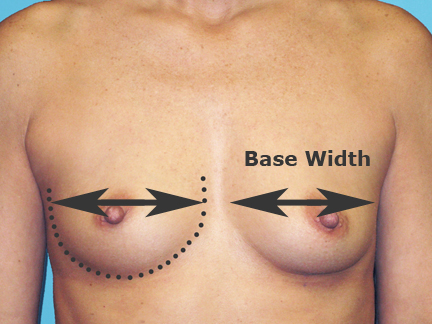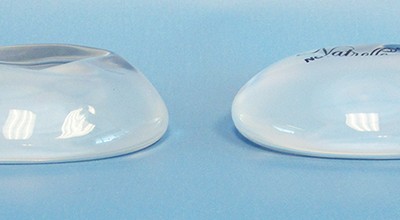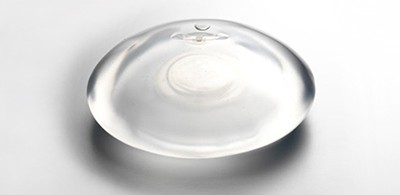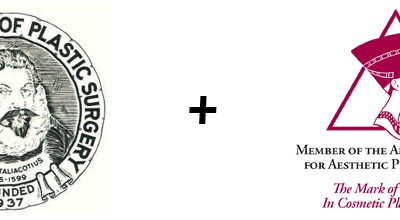
Dimensional Planning
What is the Priority for Breast Implant Selection?
Surgeons have often prioritized a woman’s desires over her tissues. In other words, delivering what a patient wants (or think she wants) with little regard for the potential short-term and long-term consequences to the patient’s tissues. The larger any breast, whether augmented or not, the worse the breast will look over time. With age, the breast tissues provide less support for the weight of the breast. Large breast implants, with significantly greater weight, cause more stretching and thinning of the soft tissue envelope; this can possibly lead to a variety of undesirable outcomes that require re-operations, additional costs, and maybe even produce deformities that cannot be satisfactorily corrected.
Dimensional planning refers to the philosophy of basing breast implant selection on the tissue characteristics and breast measurements of each individual patient. Utilizing this approach the breast implant is specifically sized for each woman in a manner that respects the nascent breast tissue and skin envelope. By not exceeding the limitations put forth by Mother Nature, it is believed that a more natural long-term result can be achieved with less morbidity.
Biodimensional® planning was a concept introduced by Dr. John Tebbetts and the McGhan Corporation in 1994. The information on this page is based upon that technique, and discusses some of the principles important to breast implant selection. Quantitative assessment of a woman’s tissue characteristics, and implant selection based upon these numbers, should be considered the logical approach to operative planning.
Dimensional Analysis and Planning in Breast Augmentation
Breast implant selection is initiated during the pre-operative consultation with a discussion of the patient’s goals. Women usually communicate their desired breast size by a bra cup size. However, cup size is not very specific and can vary tremendously based upon the bra manufacturer. A discussion of breast implant volume is much more useful. And though it is difficult to guarantee a specific cup size, it is easier to closely approximate a desired volume.
1. Carefully analyze the shape, and measure the dimensions of the existing breasts.
Breast implant size is further refined by the surgeon’s examination and assessment. The most important factors used for selecting a specific implant size are the dimensions of the nascent breast, and the compliance and characteristics of the soft tissue envelope.
 The base-width [BW] of the breast is related to the width of the patient’s chest and is proportional to the overall body habitus. It is imperative that the breast base-width be respected during augmentation in order to maintain the normal anatomical landmarks of the breast. Generally, the surgeon should select an implant that is slightly less wide than the existing breast. Choosing a breast implant diameter that will fit within the base-width of the breast will preserve the lateral breast fold and the intermammary distance. The same is true for breast height, but to a lesser extent. Violation of these landmarks may yield an unnatural and malformed appearance.
The base-width [BW] of the breast is related to the width of the patient’s chest and is proportional to the overall body habitus. It is imperative that the breast base-width be respected during augmentation in order to maintain the normal anatomical landmarks of the breast. Generally, the surgeon should select an implant that is slightly less wide than the existing breast. Choosing a breast implant diameter that will fit within the base-width of the breast will preserve the lateral breast fold and the intermammary distance. The same is true for breast height, but to a lesser extent. Violation of these landmarks may yield an unnatural and malformed appearance.
2. Analyze the character and evaluate the adequacy of soft tissue envelope.
The thickness and elasticity (compliance) of the skin envelope is assessed by pinch and stretch. Pinch thickness [PT] measurements are performed in the upper pole and lower pole of the beast to assess the adequacy of the soft tissue covering. The distance between the nipple and the inframammary fold [N-IMF] is measured under maximum stretch to assess the elasticity of the skin envelope.
Ensuring optimal soft tissue coverage over the breast implant is the primary priority in a successful augmentation. For optimal long-term aesthetic results, it is important to avoid an implant size that exceeds the capacity of the woman’s skin envelope.
When an excessively large implant is placed in any envelope the long–term effects may not be ideal. The excessive stretch and pressure produced by an oversized implant may result in the formation of stretch marks, breast gland atrophy, skin thinning, visible or palpable implant edges, visible traction rippling, disproportionate stretching of the lower pole, inferior implant malposition, double-bubble deformity, and breast sagging.
3. Select implant size, shape, height, width, and projection to develop an anatomically well-defined goal for the breast shape after augmentation.
The ultimate decision of which implant to use is based upon a thorough evaluation of the woman’s anatomy and available tissue, the surgeon’s assessment of the volume needed to optimize the soft tissue envelope, and the patient’s understanding of the trade-offs between implant size and long-term results. The best approach to achieve a long-term natural looking result is to fill the existing skin envelope adequately, but avoid excessively large implants that cause progressive deterioration of the soft tissues.
The measurements and assessment obtained during the physical examination are used to estimate the breast implant volume that will best fit beneath the nascent breast. It is important to reconcile the patient’s desires with any tissue limitations and trade-offs that exist. The final volume can then be selected based upon the patient’s desires and the surgeon’s wishes. When a woman requests an implant size (volume) that exceeds the capacity of her tissue envelope it is important that she fully understand the potential long-term adverse effects on the soft tissue and the potential risk for additional re-operations.
In the end, prioritizing soft tissue protection can almost always prevent unsatisfactory outcomes.
NEXT TOPIC: Breast Augmentation & Breast Lift
What is the Gel-to-Shell Fill Volume Ratio?
Each round silicone gel-filled breast implant is comprised of a silicone elastomer shell which contains the silicone gel filling. Silicone gel breast implants are filled by the manufacturer with a moderately cohesive (responsive) silicone gel. If you look carefully at...
How Firm is a Saline Breast Implant?
During the consultation today, a patient asked me, "Aren't saline implants harder?" Well, it actually depends. Let me start by saying that if you have ever held a saline implant and a silicone gel implant side-by-side, you know that they feel completely different, and...
Why is a board certified plastic surgeon important for my breast augmentation?
I recently saw a woman in consultation for a failed saline breast implant. She had her breast augmentation performed seven years earlier by a surgeon who advertises like a plastic surgeon, but is not board certified in plastic surgery. And as far as I am aware, has...



